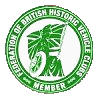The name was used by Shakespeare in his play The Tempest. He used the name to describe his airy spirit, loosely based upon the Roman messenger of the Gods, Mercury. Just why the Ariel concern should come to adopt the name of a Shakespeare character, is a complex story.
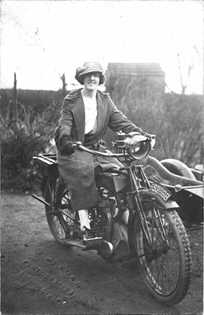 First used to name a bicycle concern, the Ariel name went on to become the make we
all know and love. James Starley began his revolution of the
cycle industry in the 1870's when he went into partnership with
William Hillman, who later became better known for his cars.
Among James Starley's first innovations were the wire spoked
wheel and an all metal lightweight frame. Although still of the
ordinary or penny farthing type of cycle, it went on sale in
1871.
First used to name a bicycle concern, the Ariel name went on to become the make we
all know and love. James Starley began his revolution of the
cycle industry in the 1870's when he went into partnership with
William Hillman, who later became better known for his cars.
Among James Starley's first innovations were the wire spoked
wheel and an all metal lightweight frame. Although still of the
ordinary or penny farthing type of cycle, it went on sale in
1871.Late in 1872 the pair went their own ways. James Starley continued with his innovative machines, winning cycle races and setting speed records, and eventually set up a business with his sons. (He also had interests in sewing machine manufacture). Eventually in the late 1880's Ariel Cycles became part of the Rudge-Whitworth concern, which was itself an amalgamation of a number of smaller cycle manufacturers. Principal among these were The Rudge Cycle co and The Whitworth Cycle co. At this stage the name seems to have disappeared from the cycle salerooms.
The Ariel name was used again in the early 1890s when it was registered as a trade name and a limited amount of cycles were produced. However, around this time only one make of pneumatic bicycle tyre was mass produced and this was made by Dunlop. This tyre was to become standard fitment for almost all makes of bicycle produced in the UK, and bicycles being the only real form of transport for the population meant very big business for Dunlop. As well as producing these tyres, for which they held the patent, in 1896 Dunlop resumed bicycle manufacturing resurrecting the Dunlop Cycle Co. This was after a 2 year break in production during which they concentrated on tyre manufacturing. As you might imagine this was the cause of great unrest in the cycle manufacturing world. Other manufacturers were upset at having to fit a rival's products to their cycles and in doing so give them free publicity. It was an uncomfortable position for Dunlop, and one that could not last. The Dunlop Cycle Company therefore decided to find a new name for its bicycle producing arm. Ideally it would be with a name still associated to Dunlop.
Ariel was a name already associated with pneumatic tyres from James Starley's Ariel cycle and, was also a trade marked name that came with an earlier acquisition of the Dunlop Company. Comparison of the trademarks of the Dunlop and Ariel concerns will see little difference in the two. This was intentional to maintain the subconscious link of the two companies. The result was The Ariel Cycle Company.
In the 1890s there existed a fragmented empire known as Cycle Components Manufacturing. Cycle Components were an amalgamation of various smaller cycle concerns and as the name suggests, cycle component manufacturers. This company acquired The Ariel Cycle Co. during 1897 and moved it into the Dale Road works along with its core manufacturing business.
It was from here that the first motorised Ariel, a tricycle, was launched in 1898 and later in 1901 the first Ariel motorcycle, fitted with a Minerva engine of 211cc.From here Ariels progressed to large and medium single cylinders and occasionally a V twin, using, mostly, bought in engines or those manufactured under license. Those used included MAG, J.A.P. and AKD V twins. The singles from 1910 were mostly based on the 482cc White and Poppe SV, originally bought in, then made under license right up to 1926.
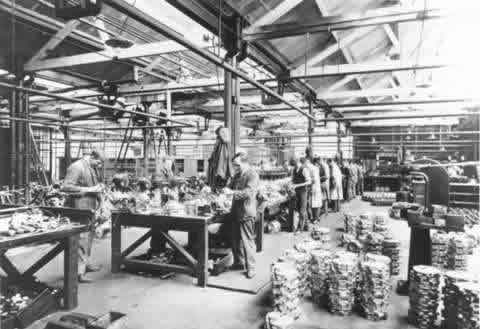 From 1901 they also made
motorcars until the middle of 1916. In 1925 Ariel employed a new
designer, fresh from J.A.P., Val Page. Val Page revolutionised
the Ariel model range from 1926. First he designed a modern
engine, but had to wait until 1927 before a frame and cycle
parts of the same quality were designed. These machines were the
beginning of what was to become the Red Hunter line, which
existed until Ariel ceased trading in four strokes in 1959. Side
valves of 250 and 557cc, OHV 's of 500cc, and a tax dodger
250cc OHV were the main stay of the marque until the Sloper
engine fad of the early '30's, including a 4 valve version.
From 1901 they also made
motorcars until the middle of 1916. In 1925 Ariel employed a new
designer, fresh from J.A.P., Val Page. Val Page revolutionised
the Ariel model range from 1926. First he designed a modern
engine, but had to wait until 1927 before a frame and cycle
parts of the same quality were designed. These machines were the
beginning of what was to become the Red Hunter line, which
existed until Ariel ceased trading in four strokes in 1959. Side
valves of 250 and 557cc, OHV 's of 500cc, and a tax dodger
250cc OHV were the main stay of the marque until the Sloper
engine fad of the early '30's, including a 4 valve version.
The introduction of Edward Turners OHC Sq 4 500cc occurred in 1931. The Sq was enlarged to 600cc for sidecar use in 1932, but shortly after this, the company went in to liquidation following the depression of the early '30's. The phoenix that arose from these ashes went on to rationalise the range back to upright singles and the 600 OHC Sq4, all installed in a more or less common frame. The classic Ariel of the 30's was of course the 500 Red Hunter with its gleaming chrome petrol tank with inset instrument panel.
Towards the end of the 30's the Sq4 became an OHV pushrod motor of, first 600cc then the 1000cc Iron engine 4G of the Pre and Post-war era. Late in the 40's Ariel introduced a 500 OHV twin designated KH. At the beginning of the 50's the Iron engined Sq4 was developed into an Alloy engined model, the MK1, which was itself superseded in 1953 by the classic 4 pipe version, the Mk2. For the next year the range of Ariels were produced in the Pivoted Rear Fork frame option, except the Sq4 which remained in a plunger frame until production ceased in 1959.
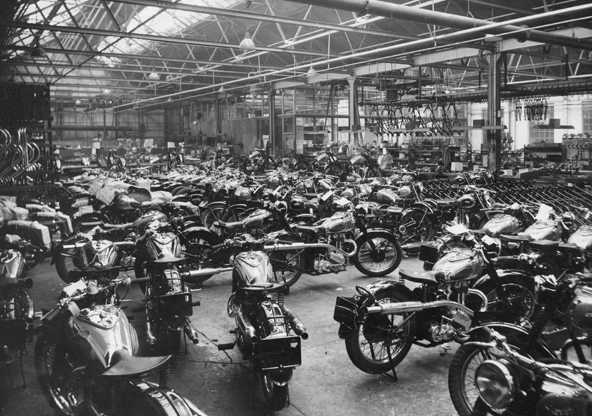
In 1954 Ariel produced the 650 Huntmaster, the engine of which was based on the BSA 650 A10, with which it shares many internal components, and also a small 200cc four stroke machine, the Ariel Colt.
The revolutionary 250cc Ariel Leader was produced from 1958 until 1966, being joined by its undressed sibling, the Ariel Arrow, in 1960. A smaller 200cc engined version came on the scene in 1964.
Ariel had much success in Trials with its 350cc and 500cc HT models and in Scrambles with the HS 500cc model; both models began their lives in 1954 and had all alloy motors and special frames for competition. The HS shared the same frame as the road going model but it was built with Reynolds tubing, and without many of the standard castings such as the rear pillion footrests. The HT had a purpose built frame and a modified gearbox, although still a Burman unit. These models enjoyed great success in the hands of people such as Sammy Miller, Ron Langston, and the trials sidecar champions Frank and Kay Wilkins.
In 1959 Ariel/BSA took the decision to stop all four stroke production and to concentrate solely on its very popular award winning Leader and Arrow models.
In 1963 BSA closed the Selly Oak works and transferred all production to Small Heath.
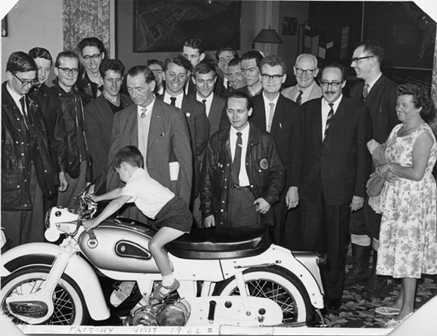 In 1963 Ariel made the
50cc Ariel Pixie. Originally designed to be an OHC engine, BSA
instructed that the BSA Beagle engine, sleeved to 50cc from
75cc, be used instead. What could have become the Honda 50, the
worlds greatest selling motorcycle, instead became just another
loss making machine which the public really didn't want.
In 1963 Ariel made the
50cc Ariel Pixie. Originally designed to be an OHC engine, BSA
instructed that the BSA Beagle engine, sleeved to 50cc from
75cc, be used instead. What could have become the Honda 50, the
worlds greatest selling motorcycle, instead became just another
loss making machine which the public really didn't want.
Sadly, the last model to bear the great Ariel name is the Ariel 3, a classic example of badge engineering by BSA. Foisted onto the Ariel Marque immediately prior to the insolvency of the BSA group with the slogan …"Here it is - whatever it is". The public, just like manufacturers, couldn't decide what it was either. What they did decide was that it wasn't what they wanted. Indeed it almost certainly was the last nail in BSA's coffin.


